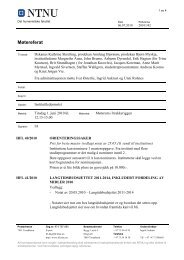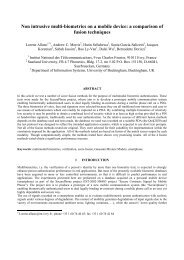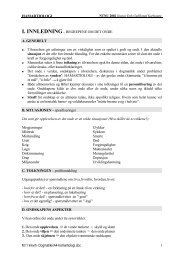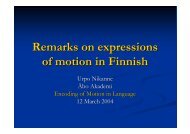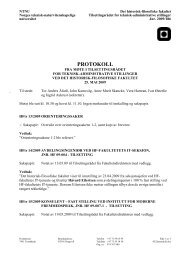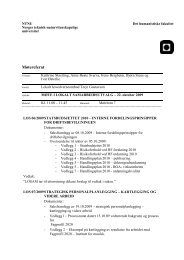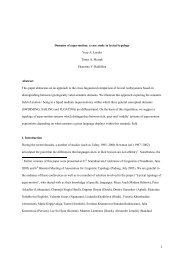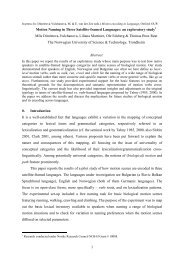The perception of articulation rate
The perception of articulation rate
The perception of articulation rate
Create successful ePaper yourself
Turn your PDF publications into a flip-book with our unique Google optimized e-Paper software.
<strong>The</strong> Perception <strong>of</strong> Articulation Rate<br />
Jacques Koreman<br />
Institute <strong>of</strong> Phonetics, Saarland University, Germany<br />
jkoreman@coli.uni-sb.de<br />
ABSTRACT<br />
Segmental as well as prosodic utterance characteristics<br />
determine listeners' <strong>perception</strong> <strong>of</strong> speaking <strong>rate</strong>. <strong>The</strong><br />
segmental characteristics are usually captured by the<br />
<strong>articulation</strong> <strong>rate</strong>, which is sometimes based on the<br />
canonical, underlying representation and at other times<br />
on the actual, surface realisation <strong>of</strong> phones in an<br />
utterance. <strong>The</strong> relation between the two is defined by the<br />
phone deletion <strong>rate</strong>. Both the underlying and the surface<br />
structure are shown to play a role in the <strong>perception</strong> <strong>of</strong><br />
speaking <strong>rate</strong> and must (in addition to other related <strong>rate</strong><br />
phenomena) be taken into account when modelling<br />
speaking <strong>rate</strong>.<br />
1. INTRODUCTION<br />
Differences in speaking <strong>rate</strong> can be reflected by a variety<br />
<strong>of</strong> phonetic and phonological properties. <strong>The</strong> number<br />
and duration <strong>of</strong> pauses [1] as well as the number and<br />
strength <strong>of</strong> prosodic phrase boundaries, the use <strong>of</strong> F0<br />
resets to signal them, the complexity <strong>of</strong> pitch accents<br />
(bitonal versus monotonal) as well as F0 range can vary<br />
with speaking <strong>rate</strong> [2-4]. Some <strong>of</strong> these characteristics<br />
have been shown to play a role in the <strong>perception</strong> <strong>of</strong><br />
speaking <strong>rate</strong> [5]. Between pauses, <strong>articulation</strong> <strong>rate</strong> also<br />
varies, though to a lesser extent than overall speaking<br />
<strong>rate</strong> – and presumably contributes to the general<br />
impression <strong>of</strong> speaking <strong>rate</strong>. Intonation phrases (IP's)<br />
have been identified as the domain <strong>of</strong> speaking <strong>rate</strong><br />
variation [6] and were selected to evaluate speaking <strong>rate</strong><br />
in the study reported here.<br />
Lindblom [7] describes speaking <strong>rate</strong> as a result <strong>of</strong> the<br />
interplay between output-oriented control, i.e. the need<br />
for a speaker to (be able to assume he will) reach his<br />
communicative goal, and system-oriented control, i.e. his<br />
tendency to "default to some low-cost form <strong>of</strong> behavior".<br />
If output-oriented constraints are strong, the speaker can<br />
either speak slowly or move his articulators from one<br />
target position to the next at greater than normal speed,<br />
resulting in a clear speaking style (hyperspeech), even at<br />
high speaking <strong>rate</strong>s. Otherwise, system-constraints, e.g.<br />
due to inertia <strong>of</strong> the articulators, will lead him to<br />
economise on his articulatory effort and adopt a relaxed,<br />
conversational speaking style (hypospeech).<br />
<strong>The</strong> difference between the two articulatory st<strong>rate</strong>gies<br />
implies that the <strong>perception</strong> <strong>of</strong> speaking <strong>rate</strong> may be a<br />
product <strong>of</strong> actual articulatory events and knowledge <strong>of</strong><br />
what <strong>articulation</strong>s are implied by a particular utterance.<br />
This is not Motor <strong>The</strong>ory in the strict sense [8], but does<br />
appeal to the listener's knowledge <strong>of</strong> the required motor<br />
patterns. <strong>The</strong> two articulatory st<strong>rate</strong>gies are indirectly<br />
reflected in the realised phone <strong>rate</strong>s and in the<br />
corresponding <strong>rate</strong>s for the intended or canonical phones<br />
(which we shall call intended <strong>rate</strong>s). In the German Kiel<br />
Corpus <strong>of</strong> Spontaneous Speech [9] the intended and<br />
realised <strong>articulation</strong> <strong>rate</strong>s <strong>of</strong> IP's show a strong overall<br />
correlation (r = 0.928, p < 0.001), cf. [10]. With<br />
increasing intended phone <strong>rate</strong>s, more phones are deleted<br />
from the canonical pronunciation (Pearson's correlation<br />
between intended phone <strong>rate</strong> and the ratio <strong>of</strong><br />
realised/intended phone <strong>rate</strong>: r = –0.515, p < 0.001), so<br />
that both the measured phone <strong>rate</strong> and the phone deletion<br />
<strong>rate</strong> are possible cues for perceived speaking <strong>rate</strong>. To test<br />
this, we used stimuli with carefully selected intended and<br />
realised phone <strong>rate</strong>s.<br />
2. METHOD<br />
Stimuli were selected from the segmentally and<br />
prosodically manually labelled German Kiel Corpus <strong>of</strong><br />
spontaneous speech. <strong>The</strong> corpus consists <strong>of</strong> high-quality<br />
recordings <strong>of</strong> conversations in which two speakers<br />
schedule one or more appointments. Despite the<br />
recording set-up, in which the speakers had to press a<br />
button to obtain the floor, the speech is very natural.<br />
Intonation phrases (IP's) were selected on the basis <strong>of</strong><br />
their intended and realised <strong>articulation</strong> <strong>rate</strong>s computed<br />
from the canonical phone representation <strong>of</strong> each phrase<br />
and the actually realised phones, respectively.<br />
Incomplete reductions (i.e. quantitative and qualitative<br />
reductions which do not entail the deletion <strong>of</strong> a complete<br />
phone segment) do not affect the realised phone <strong>rate</strong> and<br />
were therefore not taken into consideration. It is<br />
expected that phrases with more numerous deletions also<br />
show a greater number <strong>of</strong> incomplete reductions (and<br />
vice versa), since these can be considered as a less<br />
extreme but otherwise similar effect <strong>of</strong> a sloppy<br />
<strong>articulation</strong>, but their effect on <strong>perception</strong> is not<br />
investigated here. Since the phrases were to be judged in<br />
pairs, we only selected phrases <strong>of</strong> similar duration (1–1.5<br />
seconds) in order to control for a possible effects <strong>of</strong><br />
phrase duration [11]. <strong>The</strong> selected phrases varied<br />
systematically in their intended and realised <strong>articulation</strong><br />
<strong>rate</strong>s, allowing us to evaluate the effect <strong>of</strong> <strong>articulation</strong><br />
<strong>rate</strong> per se and differentiate it from that <strong>of</strong> speaking style<br />
(clear versus sloppy) on listeners' <strong>perception</strong>. Six <strong>rate</strong><br />
categories were selected (cf. Fig. 1):<br />
FC<br />
Fast, clear IP's had high intended and realised<br />
phone <strong>rate</strong>s. Intended phone <strong>rate</strong>s were between 1<br />
and 2 standard deviations above the mean. <strong>The</strong><br />
realised phone <strong>rate</strong>s were close to the intended
FS<br />
NCf<br />
phone <strong>rate</strong>s, with a low phone deletion <strong>rate</strong><br />
(maximally 8%). <strong>The</strong> realised phone <strong>rate</strong>s <strong>of</strong><br />
these phrases were about 2-3 standard deviations<br />
above the mean.<br />
<strong>The</strong> intended phone <strong>rate</strong>s for the fast but sloppy<br />
phrases were similar to those <strong>of</strong> the clear phrases,<br />
but 35–40% <strong>of</strong> the intended phones were not<br />
realised. <strong>The</strong> realised phone <strong>rate</strong> was therefore<br />
much lower than in the fast, clear category,<br />
namely within one standard deviation <strong>of</strong> the mean<br />
(all above the mean, except for two phrases).<br />
A third category <strong>of</strong> clearly spoken phrases was<br />
selected, with intended and realised phone <strong>rate</strong>s<br />
similar to the realised phone <strong>rate</strong>s <strong>of</strong> the fast,<br />
sloppy speech. <strong>The</strong> percentage <strong>of</strong> phone deletions<br />
was comparable to that in the FC category. <strong>The</strong><br />
intended phone <strong>rate</strong>s were within about 0.5<br />
standard deviation from the mean. This category<br />
is named normal, clear phrases for comparison<br />
with fast intended phrases (NCf).<br />
As we noted above, output-oriented constraints can lead<br />
a speaker to slow his speech down or increase articulator<br />
speed in order to prevent undershoot [12]. Since at fast<br />
intended <strong>articulation</strong> <strong>rate</strong>s the inertia <strong>of</strong> the articulators<br />
(which itself is constant) creates a strong force to slow<br />
down or reduce phones, the lack <strong>of</strong> phone deletions in<br />
category FC is taken as a sign <strong>of</strong> strong output-oriented<br />
constraints and therefore a clear case <strong>of</strong> hyperspeech.<br />
Conversely, the deletion <strong>of</strong> phones at slower speaking<br />
<strong>rate</strong>s is a sign <strong>of</strong> extremely lax output constraints,<br />
allowing system-oriented constraints to induce<br />
hypospeech (category NS below). In order to evaluate<br />
whether the different relative weight <strong>of</strong> output and<br />
system constraints is taken into account by the listener in<br />
his judgment <strong>of</strong> speaking <strong>rate</strong>, another set <strong>of</strong> stimuli was<br />
selected from the slower half <strong>of</strong> the intended <strong>articulation</strong><br />
<strong>rate</strong> range (normal to slow):<br />
NCs Normal, clearly spoken phrases were selected<br />
with similar intended and realised phone <strong>rate</strong>s to<br />
those <strong>of</strong> the NCf category (but with all intended<br />
phones being realised), but the phrases were<br />
different ones. This was done in order to provide<br />
an optimal match with the phrases in the two<br />
categories below.<br />
NS<br />
SC<br />
Normal but sloppy intonation phrases showed<br />
phone deletion <strong>rate</strong>s between 35–40% (as in the<br />
FS category). This resulted in fairly slow realised<br />
phone <strong>rate</strong>s between –0.5 and –1.5 standard<br />
deviations from the mean.<br />
Finally, slow, but clear phrases were selected. <strong>The</strong><br />
phrases were matched to the NS phrases in their<br />
realised <strong>articulation</strong> <strong>rate</strong>s. <strong>The</strong> intended phone<br />
<strong>rate</strong>s are between –1 and –2 standard deviations<br />
from the mean.<br />
All possible combinations <strong>of</strong> the 6 categories were<br />
compared, giving 15 comparisons. Five sets <strong>of</strong> 6 phrases<br />
mean intended <strong>rate</strong> (phones/sec)<br />
24<br />
22<br />
20<br />
18<br />
16<br />
14<br />
12<br />
10<br />
8<br />
fc<br />
fs<br />
ncf<br />
category<br />
were selected from the database. <strong>The</strong> total number <strong>of</strong><br />
stimulus pairs was therefore 5 (sets) x 15 (comparisons)<br />
= 75 per listener. <strong>The</strong> word content <strong>of</strong> the phrases was<br />
always different and with a few exceptions they were all<br />
produced by different speakers. <strong>The</strong> stimulus pairs were<br />
<strong>of</strong>fered in pseudo-randomised order. Ten female and ten<br />
male listeners with no hearing or language deficiencies<br />
aged between 20 and 59 (average: 30) participated in the<br />
listening test. <strong>The</strong> listeners were divided into two equal<br />
groups, which heard the stimuli within each pair in<br />
opposite orders. <strong>The</strong> stimuli were preceded and<br />
followed by filler items. In addition, they were mixed<br />
with a small number <strong>of</strong> similar phrases not used for this<br />
study.<br />
<strong>The</strong> "Experimenter" s<strong>of</strong>tware [13] was used to carry out<br />
the listening experiment. <strong>The</strong> stimuli, which had been set<br />
to equal loudness levels 1 , were played to the listeners<br />
over headphones in a sound-treated room at a selfselected<br />
comfortable loudness level. <strong>The</strong> stimuli were<br />
displayed orthographically on a computer screen for 3.5<br />
seconds, followed by a beep and a silent pause <strong>of</strong> 0.5<br />
seconds. <strong>The</strong>n the stimulus pair was played, sepa<strong>rate</strong>d by<br />
a silence interval <strong>of</strong> 0.5 seconds. <strong>The</strong> subject then had 5<br />
seconds to respond by pressing one <strong>of</strong> three keys on the<br />
keyboard for "first phrase faster", "second phrase faster"<br />
or "both phrases are equally fast". Response times were<br />
also registered, but not used in the present analysis.<br />
ncs<br />
Figure 1: Average intended (filled bars) and<br />
realised phone <strong>rate</strong>s (dashed bars) in phones/sec<br />
<strong>of</strong> stimuli from six <strong>rate</strong> categories (see text) –<br />
with mean and standard deviations for intended<br />
and realised <strong>rate</strong>s indicated on the vertical axes<br />
1 It may be argued that setting the loudness to an equal level<br />
for all stimuli destroys the possible relationship between <strong>rate</strong><br />
and loudness. Since the speakers were (nearly) all different<br />
and therefore have their own preferred loudness this was<br />
considered to be <strong>of</strong> minor importance. We cannot, however,<br />
exclude the possibility that the factors studied in this<br />
experiment interact with loudness.<br />
ns<br />
sc<br />
24<br />
22<br />
20<br />
18<br />
16<br />
14<br />
12<br />
10<br />
8<br />
mean realised <strong>rate</strong> (phones/sec)
3. RESULTS AND DISCUSSION<br />
In order to evaluate whether <strong>rate</strong> <strong>perception</strong> is affected<br />
by the measured <strong>rate</strong>s, the 15 stimulus pair categories are<br />
divided into four sets according to their intended and<br />
realised phone <strong>rate</strong>s (cf. Fig. 1). In set A, both the<br />
intended and the realised phone <strong>rate</strong>s <strong>of</strong> the two phrases<br />
in a stimulus pair differ. In set B, the two phrases differ<br />
only in their realised <strong>rate</strong>, while in set C there is only a<br />
difference in intended <strong>rate</strong>. In set D, finally, both the<br />
intended and realised phone <strong>rate</strong>s are the same (see<br />
Table 1).<br />
75% n=656<br />
50%<br />
25%<br />
n=19<br />
0%<br />
75%<br />
A<br />
n=125<br />
C<br />
n=138<br />
n=23<br />
B<br />
n=139<br />
D<br />
cond.<br />
int.<br />
<strong>rate</strong><br />
real.<br />
<strong>rate</strong><br />
#judgements<br />
compared <strong>rate</strong> categories<br />
A diff diff 800 FC-NCf, FC-NCs, FC-NS,<br />
FC-SC, FS-NS, FS-SC, NCf-<br />
SC, NCs-SC<br />
B same diff 300 FC-FS, NCf-NS, NCs-NS<br />
C diff same 300 FS-NCf, FS-NCs, NS-SC<br />
D same same 100 NCf-NCs<br />
Table 1: Intended and realised <strong>rate</strong>s for 4 conditions<br />
(see text), with the number <strong>of</strong> listener judgements<br />
and the compared <strong>rate</strong> conditions (cf. Fig. 1)<br />
<strong>The</strong> perceived <strong>rate</strong> distinctions are shown in Fig. 2 for<br />
each <strong>of</strong> the four sets. <strong>The</strong> responses were recoded so that<br />
the first stimulus <strong>of</strong> each pair always represents a faster<br />
intended and/or realised phone <strong>rate</strong>, although the actual<br />
order was always cross-balanced in the experiment. <strong>The</strong><br />
response "first stimulus faster" (black columns) should<br />
therefore be expected if one <strong>of</strong> the measured phone <strong>rate</strong>s<br />
determines <strong>rate</strong> <strong>perception</strong>, except in Fig. 2D, where<br />
there is no <strong>rate</strong> difference between the stimuli. Fig. 2A<br />
shows that listeners clearly perceive the expected <strong>rate</strong><br />
difference if both the intended and realised <strong>rate</strong>s <strong>of</strong> the<br />
two IP's differ (82% "stim1 faster" responses), with<br />
relatively few "equal" responses (16%). More "equal"<br />
and fewer "stim1 faster" responses are given when only<br />
one <strong>of</strong> the two measured phone <strong>rate</strong>s differs for the two<br />
IP's (Fig. 2B and 2C), with somewhat more "equal" and<br />
fewer "stim1 faster" responses when there is a difference<br />
in realised rather than intended <strong>rate</strong>. <strong>The</strong> lower realised<br />
<strong>rate</strong> <strong>of</strong> the (recoded) second stimulus in each <strong>of</strong> the pairs<br />
represented in Fig. 2B causes it to be perceived as slower<br />
than the first stimulus, despite equal intended <strong>rate</strong>s. This<br />
shows that there is an effect <strong>of</strong> surface <strong>rate</strong>. In Fig. 2C,<br />
the first stimulus has a higher intended phone <strong>rate</strong> than<br />
the second stimulus and is perceived as faster, despite<br />
equal realised <strong>rate</strong>s. This therefore shows that there is<br />
also an underlying <strong>rate</strong> effect. Articulator speed,<br />
reflected in the surface or realised <strong>rate</strong>, and knowledge<br />
<strong>of</strong> the underlying or canonical form, reflected in the<br />
intended <strong>rate</strong>, therefore play a role in the <strong>perception</strong> <strong>of</strong><br />
speaking <strong>rate</strong>.<br />
<strong>The</strong> relative differences between Figs. 2B and 2C (more<br />
"stim1 faster" and fewer "equal" responses in Fig. 2C)<br />
should not be taken as an indication that the intended<br />
50%<br />
25%<br />
0%<br />
n=165<br />
n=25<br />
stim1 faster stim2 faster<br />
response<br />
n=110<br />
equal<br />
n=21<br />
n=32<br />
stim1 faster stim2 faster<br />
response<br />
n=47<br />
equal<br />
Figure 2: Listener responses (percentages) to<br />
stimuli with different intended and realised <strong>rate</strong>s<br />
(A), only different realised <strong>rate</strong>s (B) or intended<br />
<strong>rate</strong>s (C), or with both equal (D).<br />
<strong>rate</strong> is <strong>of</strong> greater importance for <strong>rate</strong> <strong>perception</strong> than the<br />
realised <strong>rate</strong>, since the differences in <strong>rate</strong> values in terms<br />
<strong>of</strong> their variation (i.e. in terms <strong>of</strong> z-scores) are not<br />
identical in this study. As expected, when both the<br />
intended and the realised <strong>rate</strong>s <strong>of</strong> the two phrases in the<br />
stimulus pair are the same (Fig. 2D), the highest<br />
percentage <strong>of</strong> "equal" reponses are given 2 (comparable to<br />
when there is only a difference in realised <strong>rate</strong>), and<br />
there is no clear tendency for one <strong>of</strong> the stimuli to be<br />
perceived as faster.<br />
<strong>The</strong> clear perceptual effect <strong>of</strong> differences in intended and<br />
realised <strong>rate</strong>s is consistently reproduced when we<br />
compare each two <strong>rate</strong> categories in Fig. 3 (next page).<br />
<strong>The</strong>re are no qualitative differences in <strong>rate</strong> <strong>perception</strong> in<br />
the upper half <strong>of</strong> the intended <strong>rate</strong> range (dashed graphs)<br />
compared to the lower half <strong>of</strong> the range (dotted graphs).<br />
This seems to indicate that the stronger system-oriented<br />
constraints in fast hyperspeech do not lead the listener to<br />
judge speaking <strong>rate</strong> differently at high <strong>articulation</strong> <strong>rate</strong>s<br />
from clear speech at normal and slow intended <strong>rate</strong>s. <strong>The</strong><br />
deletion <strong>of</strong> phones at normal speaking <strong>rate</strong>, too, has no<br />
qualitatively different effect on the <strong>perception</strong> <strong>of</strong><br />
speaking <strong>rate</strong> from phone deletion at fast speaking <strong>rate</strong>s,<br />
although sloppiness at normal intended <strong>rate</strong>s can be<br />
considered as a clear indication <strong>of</strong> extremely lax system<br />
constraints.<br />
2 <strong>The</strong> reason why there are many "stim1 faster" and "stim2<br />
faster" responses instead <strong>of</strong> only "equal" responses is<br />
probably that the listeners are induced by the task to choose<br />
one <strong>of</strong> the two stimulus as faster.
100<br />
75<br />
50<br />
25<br />
0<br />
FS<br />
100<br />
75<br />
50<br />
25<br />
0<br />
NCf<br />
100<br />
75<br />
50<br />
25<br />
0<br />
NCs<br />
100<br />
75<br />
50<br />
25<br />
0<br />
Figure 3: Percentages "stim1 faster" (black<br />
bars), "stim2 faster" (light gray bar) and "equal"<br />
(dark gray bars) averaged for each stimulus pair.<br />
Rows indicate the category <strong>of</strong> the first stimulus<br />
in a pair, while columns show the category <strong>of</strong> the<br />
second stimulus.<br />
4. GENERAL DISCUSSION<br />
SC<br />
Comparing prosodic structures differing in their surface<br />
complexity but with equal assumed underlying<br />
structures, Rietveld and Gussenhoven [5] found that<br />
resynthesised utterances with linked intonation contours<br />
are perceived as faster than utterances with physically<br />
equal speaking <strong>rate</strong> but unlinked contours. <strong>The</strong>y show<br />
this bias cannot be explained by the phonetic (number <strong>of</strong><br />
rising or falling movements) or phonological complexity<br />
(number <strong>of</strong> tone segments) <strong>of</strong> the utterance. <strong>The</strong>y<br />
conclude that the linked contour, implying absence <strong>of</strong> a<br />
tone domain boundary, causes a bias in the listener<br />
towards perceiving fast speech, beacuse linked<br />
intonation contours typically occur at faster speaking<br />
<strong>rate</strong>s.<br />
An interaction between underlying and surface<br />
realisation was also found on the segmental level in our<br />
experiment. Segment deletions as an extreme form <strong>of</strong><br />
reduction were shown to affect the <strong>perception</strong> <strong>of</strong><br />
speaking <strong>rate</strong>. A lower <strong>rate</strong> <strong>of</strong> surface events (realised<br />
phones) causes sloppy speech to be perceived as slower<br />
than clear speech when the intended <strong>rate</strong>s <strong>of</strong> the<br />
compared IP's are identical. On the other hand, the<br />
perceived speaking <strong>rate</strong> <strong>of</strong> sloppy IP's is not reduced so<br />
much that it becomes equal to that <strong>of</strong> clear IP's with the<br />
same realised <strong>rate</strong>. I.e. the <strong>perception</strong> <strong>of</strong> speaking <strong>rate</strong> in<br />
IP's is the product <strong>of</strong> the interaction between surface and<br />
underlying <strong>rate</strong>.<br />
Although the above effects are important in modelling<br />
the perceptual effects <strong>of</strong> natural speaking <strong>rate</strong>, the<br />
desirability <strong>of</strong> modelling natural speaking <strong>rate</strong> effects in<br />
speech technological applications using flexible-<strong>rate</strong><br />
synthesis remains an issue for further investigation [14].<br />
100<br />
75<br />
50<br />
25<br />
0<br />
NS<br />
FC<br />
FS<br />
NCf<br />
NCs<br />
NS<br />
REFERENCES<br />
[1] F. Goldman-Eisler, Psycholinguistics, London &<br />
New York: Academic Press, 1968.<br />
[2] C. Fougeron and S.-A. Jun, "Rate effect on French<br />
intonation: prosodic organization and phonetic<br />
realization," Journal <strong>of</strong> Phonetics, vol. 26, pp. 45–<br />
69, 1998.<br />
[3] K.J. Kohler, "Parameters <strong>of</strong> speech <strong>rate</strong> <strong>perception</strong><br />
in German words and sentences: duration, F0<br />
movement and F0 level," Language & Speech, vol.<br />
29, pp. 115–139, 1986.<br />
[4] J. Trouvain and M. Grice, "<strong>The</strong> effect <strong>of</strong> tempo on<br />
prosodic structure," Proc. 14th Int'l Conf. <strong>of</strong> the<br />
Phonetic Sciences (ICPhS), San Francisco, pp.<br />
1067-1070, 1999.<br />
[5] T. Rietveld and C. Gussenhoven, "Perceived speech<br />
<strong>rate</strong> and intonation," Journal <strong>of</strong> Phonetics, vol. 15,<br />
pp. 273–285, 1987.<br />
[6] J. Dankovičová, "Articulation <strong>rate</strong> variation within<br />
the intoantion phrase in Czech and English," Proc.<br />
14th Int'l Conf. <strong>of</strong> the Phonetic Sciences (ICPhS),<br />
San Francisco, pp. 269-272, 1999.<br />
[7] B. Lindblom, "Explaining phonetic variation: a<br />
sketch <strong>of</strong> the H&H theory," in Speech Production<br />
and Speech Modelling, W.J. Hardcastle and A.<br />
Marchal, Eds., pp. 403–439. Dordrecht/Boston/<br />
London: Kluwer Academic Publishers, 1990<br />
[8] A.M. Liberman and I.G. Mattingly, "<strong>The</strong> motor<br />
theory <strong>of</strong> speech <strong>perception</strong> revised," Cognition,<br />
vol. 21, pp. 1–36, 1985.<br />
[9] IPDS, <strong>The</strong> Kiel Corpus <strong>of</strong> Spontaneous Speech,<br />
vols. 1–3 (CD-ROM #2–4). Kiel: Insitut für<br />
Phonetik und digitale Sprachverarbeitung, 1995–<br />
1997.<br />
[10] J.Trouvain,J.Koreman,A.ErriquezandB.Braun,<br />
"Articulation <strong>rate</strong> measures and their relation to<br />
phone classification in spontaneous and read<br />
German," in: Proc. <strong>of</strong> the Isca ITR-Workshop on<br />
Adaptation Methods for Speech Recognition,<br />
Sophia-Antipolis, pp. 155-158, 2001.<br />
[11] H.R. Pfitzinger, "Local speech <strong>rate</strong> <strong>perception</strong> in<br />
German speech," Proc. 14th Int'l Conf. <strong>of</strong> the<br />
Phonetic Sciences (ICPhS), San Francisco, vol. 2,<br />
pp. 893–896, 1999<br />
[12] B. Lindblom, "Spectrographic study <strong>of</strong> vowel<br />
reduction," Journal <strong>of</strong> the Acoustical Society <strong>of</strong><br />
America, col. 35, nr. 11, pp. 1773–1781.<br />
[13] G. Altman, Experimenter. A Toolkit for Multi-Modal<br />
Psycholinguiistic Experimentation on the Apple<br />
Macintosh, Sussex: Laboratory <strong>of</strong> Eperimental<br />
Psychology, University <strong>of</strong> Sussex, 1992.<br />
[14] E. Janse, "Word <strong>perception</strong> in fast speech:<br />
artificially time-compressed vs. naturally<br />
produced fast speech," submitted to Speech<br />
Communication.



